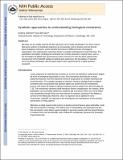| dc.contributor.author | Velenich, Andrea | |
| dc.contributor.author | Gore, Jeff | |
| dc.date.accessioned | 2014-07-24T19:35:58Z | |
| dc.date.available | 2014-07-24T19:35:58Z | |
| dc.date.issued | 2012-08 | |
| dc.identifier.issn | 13675931 | |
| dc.identifier.uri | http://hdl.handle.net/1721.1/88494 | |
| dc.description.abstract | Microbes can be readily cultured and their genomes can be easily manipulated. For these reasons, laboratory systems of unicellular organisms are increasingly used to develop and test theories about biological constraints, which manifest themselves at different levels of biological organization, from optimal gene-expression levels to complex individual and social behaviors. The quantitative description of biological constraints has recently advanced in several areas, such as the formulation of global laws governing the entire economy of a cell, the direct experimental measurement of the trade-offs leading to optimal gene expression, the description of naturally occurring fitness landscapes, and the appreciation of the requirements for a stable bacterial ecosystem. | en_US |
| dc.description.sponsorship | Alfred P. Sloan Foundation (Fellowship) | en_US |
| dc.description.sponsorship | Pew Charitable Trusts (Pew Scholars Program) | en_US |
| dc.description.sponsorship | National Science Foundation (U.S.) (NSF CAREER Award) | en_US |
| dc.description.sponsorship | National Institutes of Health (U.S.) (NIH R00 Pathway to Independence Award) | en_US |
| dc.language.iso | en_US | |
| dc.publisher | Elsevier B.V. | en_US |
| dc.relation.isversionof | http://dx.doi.org/10.1016/j.cbpa.2012.05.199 | en_US |
| dc.rights | Creative Commons Attribution-Noncommercial-Share Alike | en_US |
| dc.rights.uri | http://creativecommons.org/licenses/by-nc-sa/4.0/ | en_US |
| dc.source | PMC | en_US |
| dc.title | Synthetic approaches to understanding biological constraints | en_US |
| dc.type | Article | en_US |
| dc.identifier.citation | Velenich, Andrea, and Jeff Gore. “Synthetic Approaches to Understanding Biological Constraints.” Current Opinion in Chemical Biology 16, no. 3–4 (August 2012): 323–328. | en_US |
| dc.contributor.department | Massachusetts Institute of Technology. Department of Physics | en_US |
| dc.contributor.mitauthor | Gore, Jeff | en_US |
| dc.contributor.mitauthor | Velenich, Andrea | en_US |
| dc.relation.journal | Current Opinion in Chemical Biology | en_US |
| dc.eprint.version | Author's final manuscript | en_US |
| dc.type.uri | http://purl.org/eprint/type/JournalArticle | en_US |
| eprint.status | http://purl.org/eprint/status/PeerReviewed | en_US |
| dspace.orderedauthors | Velenich, Andrea; Gore, Jeff | en_US |
| dc.identifier.orcid | https://orcid.org/0000-0003-4583-8555 | |
| mit.license | OPEN_ACCESS_POLICY | en_US |
| mit.metadata.status | Complete | |
